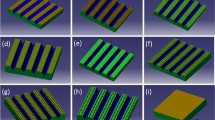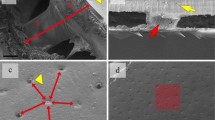Abstract
The scales of body surface of Laudakia stoliczkana have the morphology of convex hulls, which are arranged in groove structure in macroscopic scale. Its body surface skin is mainly composed of the “soft” layer of keratin and the “hard” layer of the cuticle covering on the “soft” layer. The coupling effect of the scale morphology and skin’s structure gives Laudakia stoliczkana the excellent ability to resist the sand erosion in desert environment. Inspired by the convex surface morphology and the composite structure of the “soft” and “hard” layers of the skin of Laudakia stoliczkana, the coupling bionic samples are fabricated and the erosion resistance performance is tested. The test results show that the coupling bionic samples have good erosion resistance performance and the samples with spherical convex hull exhibit the best erosion resistance performance. Moreover, based on the theory of stress wave propagation in solid the numerical simulations of particles impacting to the coupling bionic samples and bionic layered structure are done respectively and the anti-erosion mechanism of the bionic layered structure is analyzed. The simulation results are consistent with the experimental results, which show that the coupling bionic samples can effectively reduce the amplitude of the incident stress wave, and thus can prevent the failure of samples.
Similar content being viewed by others
References
Oomen H S, Abad M D, Khanna M, Veldhuis S C. Comparative wear behavior studies of coated inserts during milling of Ni Cr Mo V steel. Tribology International, 2012, 53, 115–123.
PalDey S, Deevi S C. Single layer and multilayer wear resistant coatings of (Ti,Al)N: A review. Materials Science and Engineering A, 2003, 342, 58–79.
Desale G R, Paul C P, Gandhi B K, Jain S C. Erosion wear behavior of laser clad surfaces of low carbon austenitic steel. Wear, 2009, 266, 975–987.
Wang J Z, Tu Y W, Wang M H. Back worn and protective of the turbines parts in Gezhouba power plant. China Three Gorges Construction, 2004, 6, 1–8. (in Chinese)
Yaer X, Shimizu K, Matsumoto H, Kitsudo T, Momono T. Erosive wear characteristics of spheroidal carbides cast iron. Wear, 2008, 264, 947–957.
Harsha A P, Jha S K. Erosive wear studies of epoxy-based composites at normal incidence. Wear, 2008, 265, 1129–1135.
Bai W J. Research on erosion action and mechanism of materials. Zhejiang Chemical Industry, 2004, 35, 17–20. (in Chinese)
Finnie I. Erosion of surfaces by solid particles. Wear, 1960, 3, 87–103.
Bitter J G A. A study of erosion phenomena, part I. Wear, 1963, 6, 5–21.
Bitter J G A. A study of erosion phenomena, part II. Wear, 1963, 6, 169–190.
Hutchings I M. A model for the erosion of metals by spherical particles at normal incidence. Wear, 1981, 70, 2269–2281.
Krishnamurthy N, Murali M S, Venkataraman B, Mukunda P G. Characterization and solid particle erosion behavior of plasma sprayed alumina and calcia-stabilized zirconia coatings on Al-6061 substrate. Wear, 2012, 274-275, 15–27.
Srivastava V K, Pawar A G. Solid particle erosion of glass fibre reinforced flyash filled epoxy resin composites. Composites Science and Technology, 2006, 66, 3021–3028.
Hussainova I, Schade K P. Correlation between solid particle erosion of cermets and particle impact dynamics. Tribology International, 2008, 41, 323–330.
Desale G R, Gandhi B K, Jain S C. Effect of erodent properties on erosion wear of ductile type materials. Wear, 2006, 261, 914–921.
Chen Q, Li D Y. Computer simulation of solid-particle erosion of composite materials. Wear, 2003, 255, 78–84.
Cernuschi F, Lorenzoni L, Capelli S, Guardamagna C, Karger M, Vaßenb R, Niessenc K V, Markocsand N, Menueye J, Giollif C. Solid particle erosion of thermal spray and physical vapour deposition thermal barrier coatings. Wear, 2011, 271, 2909–2918.
Ren L Q, Liang Y H. The Introduction of Bionics, China science publishing and media Ltd., Beijing, China, 2016. (in Chinese)
Ren L Q, Liang Y H. Biological couplings: Function, characteristics and implementation mode. Science China Technological Sciences, 2010, 53, 379–387.
Ren L Q, Liang Y H. Biological couplings: Classification and characteristic rules. Science in China Series E: Technological Sciences, 2009, 52, 2791–2800.
Ren L Q, Cong Q, Tong J, Chen B C. Reducing adhesion of soil against loading shovel using bionic electro-osmosis method. Terramechanics, 2001, 38, 211–219.
Ren L Q, Han Z W, Li J Q, Tong J. Experimental investigation of bionic rough curved soil cutting blade surface to reduce soil adhesion and friction. Soil and Tillage Research, 2006, 85, 1–12.
Ren L Q, Tong J, Li J Q, Chen B C. SW — Soil and Water: Soil adhesion and biomimetics of soil — engaging components: A review. Journal of Agricultural Engineering Research, 2001, 79, 239–263.
Rechenberg I, Khyari AR El. The sand skink of the Sahara: Model for friction and wear reduction. Proceedings of the International Conference of Bionic Engineering, Changchun, China, 2006, 213–216.
Han Z W, Zhang J Q, Ge C, Lü Y, Jiang J L, Liu Q P, Ren L Q. Anti-erosion function in animals and its biomimetic application. Journal of Bionic Engineering, 2010, 7, S50–S58.
Han Z W, Zhang J Q, Ge C, Wen L, Ren L Q. Erosion resistance of bionic functional surfaces inspired from desert scorpions. Langmuir, 2012, 28, 2914–2921.
Han Z W, Zhang J Q. Gas-solid erosion on bionic configuration surface. Journal of Wuhan University of Technology (Materials Science Edition), 2011, 26, 306–311.
Han Z W, Yin W, Zhang J Q, Jiang J L, Niu S C, Ren L Q. Erosion-resistant surfaces inspired by tamarisk. Journal of Bionic Engineering, 2013, 10, 479–487.
Gao F. Research on the Coupling Characteristics of Anti-erosive Wear of Desert Lizard, doctoral thesis, Jilin University, Changchun, China, 2008. (in Chinese)
Huang H, Zhang Y, Ren L Q. Particle erosion resistance of bionic samples inspired from skin structure of desert lizard, Laudakia stoliczkana. Journal of Bionic Engineering, 2012, 9, 465–469.
Zhang Y H, Huang H, Ren L Q. Erosion wear experiments and simulation analysis on bionic anti-erosion sample. Science China Technological Science, 2014, 1, 1–5.
Ruff A. W, Ives L K, Measurement of solid particle velocity in erosive wear. Wear, 1975, 35, 195–199.
Yu T X, Qiu X M. Impact Dynamics, Tsinghua University Press, Beijing, China, 2011. (in Chinese)
Acknowledgment
This research was financially supported by the Natural Science Foundation of China (51375006), Science and Technology Development Project of Jilin Province (20150519007JH and 20150101020JC).
Author information
Authors and Affiliations
Corresponding author
Rights and permissions
About this article
Cite this article
Liang, P., Sun, Y., Liu, S. et al. A Bionic Study on the Anti-erosion Mechanism of Laudakia stoliczkana: Experimental and Numerical Aspects. J Bionic Eng 16, 882–893 (2019). https://doi.org/10.1007/s42235-019-0103-7
Published:
Issue Date:
DOI: https://doi.org/10.1007/s42235-019-0103-7




